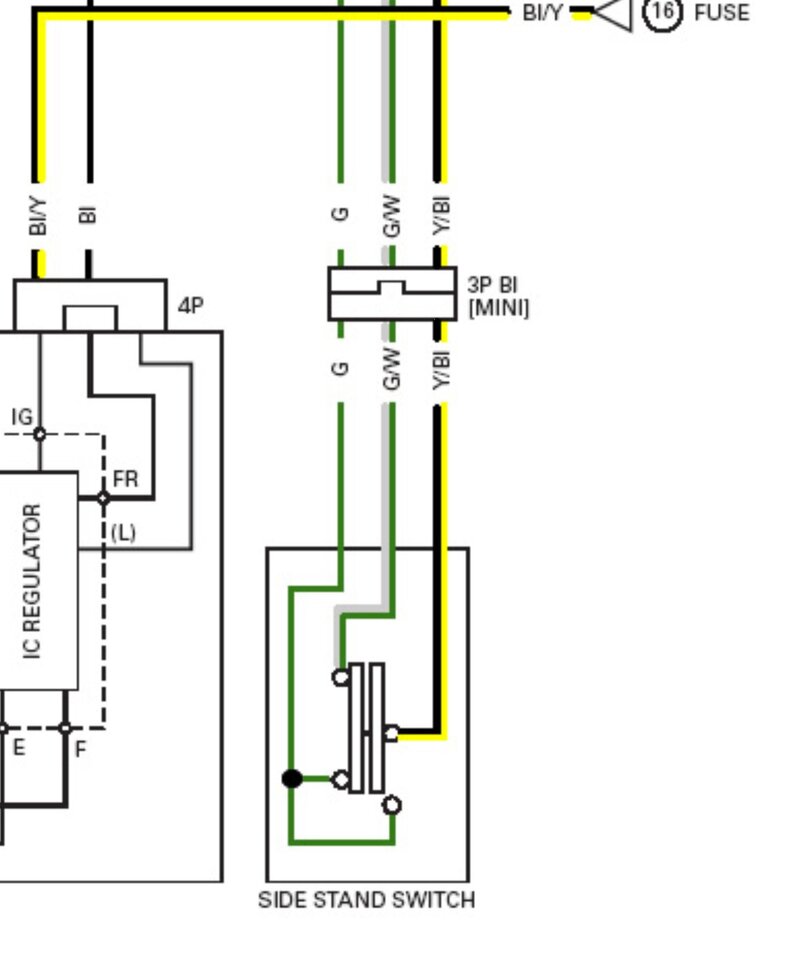I rode about 40 miles in rain heavy enough for cars to pull over last night. My Fi light came on . I thought I would check it out how many blinks came up today . I just drove 4 miles this morning and it would not come on . My question is could the wet wiring cause the light to come on ? Or is there a way I can check it out without the light being lit. Im leaving on a 600 mile trip in a few days.
Navigation
Install the app
How to install the app on iOS
Follow along with the video below to see how to install our site as a web app on your home screen.
Note: This feature may not be available in some browsers.
More options
You are using an out of date browser. It may not display this or other websites correctly.
You should upgrade or use an alternative browser.
You should upgrade or use an alternative browser.
F1 code in rain
- Thread starter Road Rider
- Start date
I would say its the rain, Is there a way to pull up inactive codes....:Shrug:
lgjhn
200+ Posts
IF it wasn't flashing, but just "on" and didn't come back on, I'd say it was just a fluke, probably due to dampness from the rain.
IF it does come back on, do NOT turn the bike off.
Put it neutral, then count the flashes, long ones and short ones.
From that count, you can get the code that's caused by the fault to give you an idea of what's causing it.
For an example: 2 longs and 3 shorts = 23.....or 9 shorts = 9
I thought I saw somewhere on here where someone posted the F1 codes. IF not, I can probably find em if you need them.
IF it does come back on, do NOT turn the bike off.
Put it neutral, then count the flashes, long ones and short ones.
From that count, you can get the code that's caused by the fault to give you an idea of what's causing it.
For an example: 2 longs and 3 shorts = 23.....or 9 shorts = 9
I thought I saw somewhere on here where someone posted the F1 codes. IF not, I can probably find em if you need them.
I don't have any Stallion experience Don but I know the GL1800 will code sometimes if ridden in the rain. My '01 did that one time. Never happen again. My '06 and now my '15 never have coded. Probably just a fluke. :xszpv: :xszpv:
I rode about 40 miles in rain heavy enough for cars to pull over last night. My Fi light came on . I thought I would check it out how many blinks came up today . I just drove 4 miles this morning and it would not come on . My question is could the wet wiring cause the light to come on ? Or is there a way I can check it out without the light being lit. Im leaving on a 600 mile trip in a few days.
Last year during a ride to Arkansas my Fi light came on. I stopped and killed the bike under a shed and grabbed the phone to look up what it was. I decided that it was the rain so I cranked the bike back up and the light went off. I have been in lots of rain since and put 8000 miles on it and never did come back on. So, I expect it was the rain that caused it and wouldn't worry about it. In fact I had forgot about it until I read your post.
- Thread starter
- #6
Last year during a ride to Arkansas my Fi light came on. I stopped and killed the bike under a shed and grabbed the phone to look up what it was. I decided that it was the rain so I cranked the bike back up and the light went off. I have been in lots of rain since and put 8000 miles on it and never did come back on. So, I expect it was the rain that caused it and wouldn't worry about it. In fact I had forgot about it until I read your post.
I would say you are correct about the fluke I have rode 900 sunny miles and the light has not came back on . I guess I have to change my profile since I got my Goldwing trike two years ago.
paid4c4
300+ Posts
So what does an F1 code mean?
Bill
Bill
So what does an F1 code mean?
Bill
Bill F1 is really FI. Fault Indicator Codes. Somewhere way back someone started calling it F1 and that stuck... In case you don't already know, there is a series of long and short blinks that will tell you what system/circuit is failing. This is long but for those that do not have it already worth printing out. :xszpv::xszpv:
If FI (Fault Indicator) light comes on pull over but DO NOT shut bike off. Put in neutral and put side stand down, RPM’s below 1500. This signals the ECM to send the error code to the FI light. Count the number of long and short flashes. This will give you the error code. Also known as Malfunction Indicator Light (MIL)
If you shut the bike off the error code is lost - sort of. It will be retained in the ECM but it is harder to get out. If the bike stops and will not restart you can get the FI light to flash the error code by cranking the engine for 10 seconds. The FI light will then flash the error code.
Long Blink = 10 Short Blink = 1
i.e. long long long short short short = 33 check error code 33
Number of MIL blinks .Symptoms
.Cause
0 No blinks • Engine does not start
• Open circuit in the power input and ground wires of the ECM: • Faulty bank angle sensor
• Open circuit in bank angle sensor related wires: • Faulty FI IGN relay: • Open circuit in FI IGN relay related wires
• Faulty engine stop switch: • Open circuit in engine stop switch related wires: • Faulty ECM: • Blown FI IGN fuse (20 A)
• Blown ST. KILL fuse (10 A):
0 No blinks • Engine operates normally
• Open circuit in MIL wire: • Faulty combination meter: • Faulty ECM
0 Stays lit • Engine operates normally
• Short circuit in service check connector wire: • Short circuit in MIL wire: • Faulty ECM
1 Blinks • Engine operates normally
• Loose or poorly connected MAP sensor connector: • Open or short circuit in MAP sensor wire: • Faulty MAP sensor
7 Blinks • Hard to start at a low temperature (ECM controls using preset value; coolant temperature: 85° C/185° F)
• Loose or poorly connected ECT sensor connector: • Open or short circuit in ECT sensor wire: • Faulty ECT sensor
8 Blinks • Poor engine response when operating the throttle quickly (ECM controls using preset value; throttle opening: 0° )
• Loose or poorly connected TP sensor connector: • Open or short circuit in TP sensor wire: • Faulty TP sensor
9 Blinks • Engine operates normally (ECM controls using preset value; intake air temperature: 28° C/82° F)
• Loose or poorly connected IAT sensor connector
• Open or short circuit in TP sensor wire: • Faulty IAT sensor
10 Blinks • Engine operates normally at low altitude
• Engine idles roughly at a high altitude (ECM controls using preset value; barometric pressure: 760 mm Hg/1,013 hPa)
• Loose or poorly connected BARO sensor connector: • Open or short circuit in BARO sensor wire: • Faulty BARO sensor
11 Blinks • Engine operates normally
• Loose or poorly connected vehicle speed sensor connector
• Open or short circuit in vehicle speed sensor wire: • Faulty vehicle speed sensor
12 Blinks • Engine does not start
• Loose or poorly connected No. 1 injector connector: • Open or short circuit in No. 1 injector wire: • Faulty No. 1 injector
13 Blinks • Engine does not start
• Loose or poorly connected No. 2 injector connector: • Open or short circuit in No. 2 injector wire: • Faulty No. 2 injector
14 No blinks • Engine does not start
• Loose or poorly connected No. 3 injector connector: • Open or short circuit in No. 3 injector wire: • Faulty No. 3 injector
15 Blinks • Engine does not start
• Loose or poorly connected No. 4 injector connector: • Open or short circuit in No. 4 injector wire: • Faulty No. 4 injector
16 Blinks • Engine does not start
• Loose or poorly connected No. 5 injector connector: • Open or short circuit in No. 5 injector wire: • Faulty No. 5 injector
17 Blinks • Engine does not start
• Loose or poorly connected No. 6 injector connector: • Open or short circuit in No. 6 injector wire: • Faulty No. 6 injector
18 Blinks • Engine does not start
• Loose or poorly connected camshaft position sensor connector
• Open or short circuit in camshaft position sensor wire: • Faulty camshaft position sensor
19 Blinks • Engine does not start
• Loose or poorly connected ignition pulse generator connector:
• Open or short circuit in ignition pulse generator wire: • Faulty ignition pulse generator
21 Blinks • Engine operates normally
• Open or short circuit in right O2 sensor wire: • Faulty right O2 sensor
22 Blinks • Engine operates normally
• Open or short circuit in left O2 sensor wire: • Faulty left O2 sensor
23 Blinks • Engine operates normally
• Open or short circuit in right O2 sensor heater wire: • Faulty right O2 sensor
24 Blinks • Engine operates normally
• Open or short circuit in left O2 sensor heater wire: • Faulty left O2 sensor
25 Blinks • Engine operates normally
• Loose or poorly connected right knock sensor connector: • Open or short circuit in right knock sensor wire: • Faulty right knock sensor
26 Blinks • Engine operates normally
• Loose or poorly connected left knock sensor connector: • Open or short circuit in left knock sensor wire: • Faulty left knock sensor
29 Blinks • Engine stalls, hard to start, rough idling
• Loose or poorly connected idle air control (IAC) valve connector: • Open or short circuit in IAC valve wire: • Faulty idle air control valve
33 Blinks • ECM does not hold the self diagnostic data
• Faulty E2-PROM in ECM • Engine operates normally
41 No blinks • Engine operates normally
• Loose or poorly connected connector in gear position switch related circuits
• Open or short circuit in gear position switch wires: • Faulty gear position switch: • Faulty clutch switch: • Faulty side stand switch
...................
Engine cranks but won’t start
• No fuel in tank, • No fuel to injector, – Clogged fuel filter, – Pinched or clogged fuel feed hose, – Pinched or clogged fuel tank breather tube, – Faulty fuel pump, – Faulty fuel pump circuits, • Intake air leak, • Contaminated / deteriorated fuel, • Faulty fuel injector, • Idle air control valve stuck closed, • No spark at plug Faulty ignition system
Engine stalls, hard to start, rough idling
• Restricted fuel feed hose, • Contaminated/deteriorated fuel, • Intake air leak, • Faulty idle air control valve, • Restricted fuel tank breather tube, • Misadjusted idle adjusting screw, • Faulty ignition system
Afterburn when engine braking is used
• Faulty pulse secondary air injection (PAIR) system, – Faulty PAIR control solenoid valve, – Faulty PAIR check valve, – Clogged hose of the PAIR system, • Faulty ignition system
Backfiring or misfiring during acceleration
• Faulty ignition system
Poor performance drive-ability and poor fuel economy
• Pinched or clogged fuel feed hose, • Faulty pressure regulator, • Faulty ignition system
paid4c4
300+ Posts
Goldrush, thank you for the answer to F1 or FI. I have printed it out and will put it in my emergency tool kit. This should be a sticky somewhere.
Bill
Bill
Goldrush, thank you for the answer to F1 or FI. I have printed it out and will put it in my emergency tool kit. This should be a sticky somewhere.
Bill
Hey Bill, do you have the side stand still on your trike? To read FI codes you need to be able to put the side stand down or simulate doing so. There are a couple ways to do that depending on how the installer did things..
If no ground effects (running boards, aqua shields, wing guards, etc) were installed a lot of installers just leave the side and center stand. If they do remove the side stand, some zip tie the switch in the up position so with a little finesse it can be manipulated to the side stand down position (S) showing on dash). If they cut the wires and fixed it to simulate side stand up all the time things get interesting.
I personally like the third option. I installed a single pole double throw toggle switch to replace the side stand switch. Here is a wire diagram of the switch for anyone interested. Green wire to switch common and the other two wires to the other two connections. I mounted my switch in the gas fill area for easy access. In the up position side stand up is simulated -- down it simulates side stand down. :xszpv: :xszpv:

Bill F1 is really FI. Fault Indicator Codes. Somewhere way back someone started calling it F1 and that stuck... In case you don't already know, there is a series of long and short blinks that will tell you what system/circuit is failing. This is long but for those that do not have it already worth printing out. :xszpv::xszpv:
If FI (Fault Indicator) light comes on pull over but DO NOT shut bike off. Put in neutral and put side stand down, RPM’s below 1500. This signals the ECM to send the error code to the FI light. Count the number of long and short flashes. This will give you the error code.
Also known as Malfunction Indicator Light (MIL)
If you shut the bike off the error code is lost - sort of. It will be retained in the ECM but it is harder to get out. If the bike stops and will not restart you can get the FI light to flash the error code by cranking the engine for 10 seconds. The FI light will then flash the error code.
Long Blink = 10 Short Blink = 1
i.e.
long long long short short short = 33 check error code 33
Number of MIL blinks .Symptoms
.Cause
0 No blinks • Engine does not start
• Open circuit in the power input and ground wires of the ECM: • Faulty bank angle sensor
• Open circuit in bank angle sensor related wires: • Faulty FI IGN relay: • Open circuit in FI IGN relay related wires
• Faulty engine stop switch: • Open circuit in engine stop switch related wires: • Faulty ECM: • Blown FI IGN fuse (20 A)
• Blown ST. KILL fuse (10 A):
0 No blinks • Engine operates normally
• Open circuit in MIL wire: • Faulty combination meter: • Faulty ECM
0 Stays lit • Engine operates normally
• Short circuit in service check connector wire: • Short circuit in MIL wire: • Faulty ECM
1 Blinks • Engine operates normally
• Loose or poorly connected MAP sensor connector: • Open or short circuit in MAP sensor wire: • Faulty MAP sensor
7 Blinks • Hard to start at a low temperature (ECM controls using preset value; coolant temperature: 85° C/185° F)
• Loose or poorly connected ECT sensor connector: • Open or short circuit in ECT sensor wire: • Faulty ECT sensor
8 Blinks • Poor engine response when operating the throttle quickly (ECM controls using preset value; throttle opening: 0° )
• Loose or poorly connected TP sensor connector: • Open or short circuit in TP sensor wire: • Faulty TP sensor
9 Blinks • Engine operates normally (ECM controls using preset value; intake air temperature: 28° C/82° F)
• Loose or poorly connected IAT sensor connector
• Open or short circuit in TP sensor wire: • Faulty IAT sensor
10 Blinks • Engine operates normally at low altitude
• Engine idles roughly at a high altitude (ECM controls using preset value; barometric pressure: 760 mm Hg/1,013 hPa)
• Loose or poorly connected BARO sensor connector: • Open or short circuit in BARO sensor wire: • Faulty BARO sensor
11 Blinks • Engine operates normally
• Loose or poorly connected vehicle speed sensor connector
• Open or short circuit in vehicle speed sensor wire: • Faulty vehicle speed sensor
12 Blinks • Engine does not start
• Loose or poorly connected No.
1 injector connector: • Open or short circuit in No. 1 injector wire: • Faulty No. 1 injector
13 Blinks • Engine does not start
• Loose or poorly connected No. 2 injector connector: • Open or short circuit in No. 2 injector wire: • Faulty No. 2 injector
14 No blinks • Engine does not start
• Loose or poorly connected No. 3 injector connector: • Open or short circuit in No. 3 injector wire: • Faulty No. 3 injector
15 Blinks • Engine does not start
• Loose or poorly connected No. 4 injector connector: • Open or short circuit in No.
4 injector wire: • Faulty No. 4 injector
16 Blinks • Engine does not start
• Loose or poorly connected No. 5 injector connector: • Open or short circuit in No. 5 injector wire: • Faulty No. 5 injector
17 Blinks • Engine does not start
• Loose or poorly connected No. 6 injector connector: • Open or short circuit in No. 6 injector wire: • Faulty No.
6 injector
18 Blinks • Engine does not start
• Loose or poorly connected camshaft position sensor connector
• Open or short circuit in camshaft position sensor wire: • Faulty camshaft position sensor
19 Blinks • Engine does not start
• Loose or poorly connected ignition pulse generator connector:
• Open or short circuit in ignition pulse generator wire: • Faulty ignition pulse generator
21 Blinks • Engine operates normally
• Open or short circuit in right O2 sensor wire: • Faulty right O2 sensor
22 Blinks • Engine operates normally
• Open or short circuit in left O2 sensor wire: • Faulty left O2 sensor
23 Blinks • Engine operates normally
• Open or short circuit in right O2 sensor heater wire: • Faulty right O2 sensor
24 Blinks • Engine operates normally
• Open or short circuit in left O2 sensor heater wire: • Faulty left O2 sensor
25 Blinks • Engine operates normally
• Loose or poorly connected right knock sensor connector: • Open or short circuit in right knock sensor wire: • Faulty right knock sensor
26 Blinks • Engine operates normally
• Loose or poorly connected left knock sensor connector: • Open or short circuit in left knock sensor wire: • Faulty left knock sensor
29 Blinks • Engine stalls, hard to start, rough idling
• Loose or poorly connected idle air control (IAC) valve connector: • Open or short circuit in IAC valve wire: • Faulty idle air control valve
33 Blinks • ECM does not hold the self diagnostic data
• Faulty E2-PROM in ECM • Engine operates normally
41 No blinks • Engine operates normally
• Loose or poorly connected connector in gear position switch related circuits
• Open or short circuit in gear position switch wires: • Faulty gear position switch: • Faulty clutch switch: • Faulty side stand switch
...................
Engine cranks but won’t start
• No fuel in tank, • No fuel to injector, – Clogged fuel filter, – Pinched or clogged fuel feed hose, – Pinched or clogged fuel tank breather tube, – Faulty fuel pump, – Faulty fuel pump circuits, • Intake air leak, • Contaminated / deteriorated fuel, • Faulty fuel injector, • Idle air control valve stuck closed, • No spark at plug Faulty ignition system
Engine stalls, hard to start, rough idling
• Restricted fuel feed hose, • Contaminated/deteriorated fuel, • Intake air leak, • Faulty idle air control valve, • Restricted fuel tank breather tube, • Misadjusted idle adjusting screw, • Faulty ignition system
Afterburn when engine braking is used
• Faulty pulse secondary air injection (PAIR) system, – Faulty PAIR control solenoid valve, – Faulty PAIR check valve, – Clogged hose of the PAIR system, • Faulty ignition system
Backfiring or misfiring during acceleration
• Faulty ignition system
Poor performance drive-ability and poor fuel economy
• Pinched or clogged fuel feed hose, • Faulty pressure regulator, • Faulty ignition system
Thanks but, for what it's worth, I think I'll have my wrench worry about stuff like this.
I never realized how sophisticated a Goldwing is, and yet bring us so much pleasure.
Either way, for those that are interested in this "blinking" stuff, Thanks for posting.
Thanks but, for what it's worth, I think I'll have my wrench worry about stuff like this.
I never realized how sophisticated a Goldwing is, and yet bring us so much pleasure.
Either way, for those that are interested in this "blinking" stuff, Thanks for posting.
10-4 Mike!! Some us just like blinky things more than others.. Old habits are hard to break. :xszpv: :xszpv:
Similar threads
- Replies
- 8
- Views
- 26,224
- Replies
- 5
- Views
- 17,586
- Replies
- 19
- Views
- 23,610
- Replies
- 9
- Views
- 11,158






